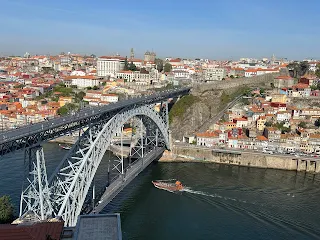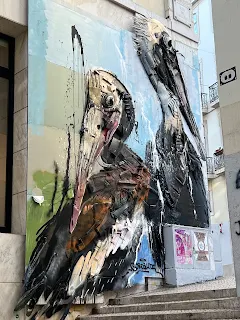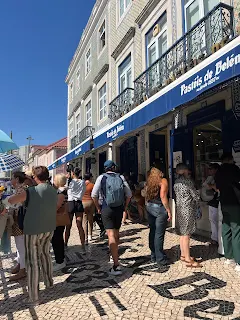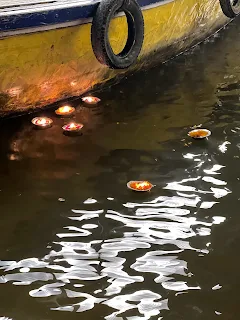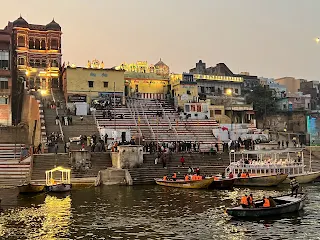Arrival in Porto
Arriving in Porto sets the stage for an enchanting evening in this Portuguese gem. After settling into your hotel or apartment, take a moment to freshen up and unwind. But don't linger too long, for the city has a delightful evening to offer. Start by strolling to the near by Monastery of Serra do Pilar, where you'll be rewarded with a magnificent view of Porto, particularly as the sun sets, painting the sky with warm hues. It's a breathtaking sight.
As the evening deepens, continue your adventure on the Gaia side of the Ribeira. Wander the narrow cobbled streets in the Wow cultural district. Walk towards the river and you'll find a plethora of charming cafes by the riverside offering many dining choices. Opt for a table facing the Porto side, to a stunning sunset spectacle. The lit bridge, the monastic silhouette, and the illuminated buildings on the Porto waterfront create a picturesque panorama that's just amazing.
 |
| Serra do Pilar |
Day 1
Rise early next morning to embark on a day of exploration in Porto, Portugal. There is much to see, and your first stop should be Sao Bento, a place that's often hailed as one of the most beautiful train stations in the world – and rightly so. As you step into the station, you'll be greeted by a breathtaking sight. The walls are adorned with intricate blue and white azulejo tiles that tell the stories of Portugal's rich history. These meticulously hand-painted tiles transform the station into a living work of art, capturing the essence of the country's culture and heritage. Sao Bento is not just a transportation hub; it's a historical and architectural gem that will leave you in awe of the craftsmanship that went into its creation. So, rise early, and let Sao Bento be your first glimpse into the captivating beauty of Porto.
Once you've marveled at the artistic beauty of Sao Bento, stroll over to the Cathedral. As you ascend to the top, be sure to pause and wonder at the hand-painted tiled wall. Each tile tells a unique story, and the intricate details are bound to leave you in awe. It's a moment of quiet appreciation.
 |
| Sao Bento |
 |
| Porto Cathedral |
If you did not go to the Monastery the evening before, now is another opportunity. Walk across the Ponte Luiz bridge and climb up the monastery for a great view.
Return to Sao Bento but continue towards the city hall. Along the way stop to admire what might possibly be the most beautiful McDonald Imperial.
On the right hand side of the city hall is a shopping district. Go to Majestic Cafe, where JK Rowling wrote several chapters of the first Harry Potter book, the Sorcerer Stone. Grab lunch at the cafe and walk about the lively shopping district.
 |
| Majestic Cafe |
Walk to the Igreja des Carmelitas and then on to Tower (Torre de Clerigos). If its still early in the afternoon, this might be a good time for a short break and to rest.
Walk on to Mercado Ferreira and then on to the riverside towards the wine museum (Museum Vinho do Porto). Continue to explore the city by foot visiting the beaches of Porto where the Duoro river meets the Atlantic ocean. Walk back towards the Ribeira to enjoy rest of the evening with a glass of Sangria, music and people watching at one of the many cafes, this time on the Porto side of the river.
Day 2: Douro Valley Trip
There are many ways to visit the Douro Valley (https://www.ricksteves.com/watch-read-listen/read/articles/douro-valley-portugal), such as taking a train to and from Porto to Pinhao, or a river boat from Porto to Pinhao and back via the train. Both routes offer scenic beauty but neither will take you to visit a Quinta (vineyard). An option is to join a tour bus. We chose to rent a car and were fortunate to have a knowledgeable local guide from Porto.
Our day began early at 8:30 am, and after an hour of driving, we made a pit stop at Amarante (https://portugaltravelguide.com/amarante-portugal/), a charming town on the banks of Tâmega. A former monastery of São Gonçalo dates back to 1540 and houses a lovely interior of painted columns and a dramatic high altar. Here, we enjoyed a delicious breakfast, savoring Brioche croissants, Amarante pastries, and coffee. After breakfast, we walked over to Don Rodrigo Taberna to buy some local goat and cow milk cheese, prosciutto, chorizo and pao for lunch and to taste local green wine and red wine.
 |
| São Gonçalo |
After the picnic lunch, we drove over to Pinhao, a small town nestled in the Duoro valley, that offered a train station, a hotel, a couple of restaurants, and wine stores. From Pinhao, we embarked on an hour-long local boat trip to savor the beauty of stepped terraces in the Douro Valley (https://www.fortheloveofport.com/historic-terraces-in-the-douro/).
Heading back to Porto, the intoxicating day left us exhausted and ready for a peaceful night’s rest.
Day 3: Beaches of Porto
Our last day in Porto was a half-day, as our train back to Lisbon was in the afternoon. To make the most of our time, we asked our local guide to take us to the various beaches of Porto and Gaia. This relaxing beach excursion served as a serene conclusion to our unforgettable journey through this beautiful Portuguese city.
 |
| https://www.atlasobscura.com/places/capela-do-senhora-da-pedra |
